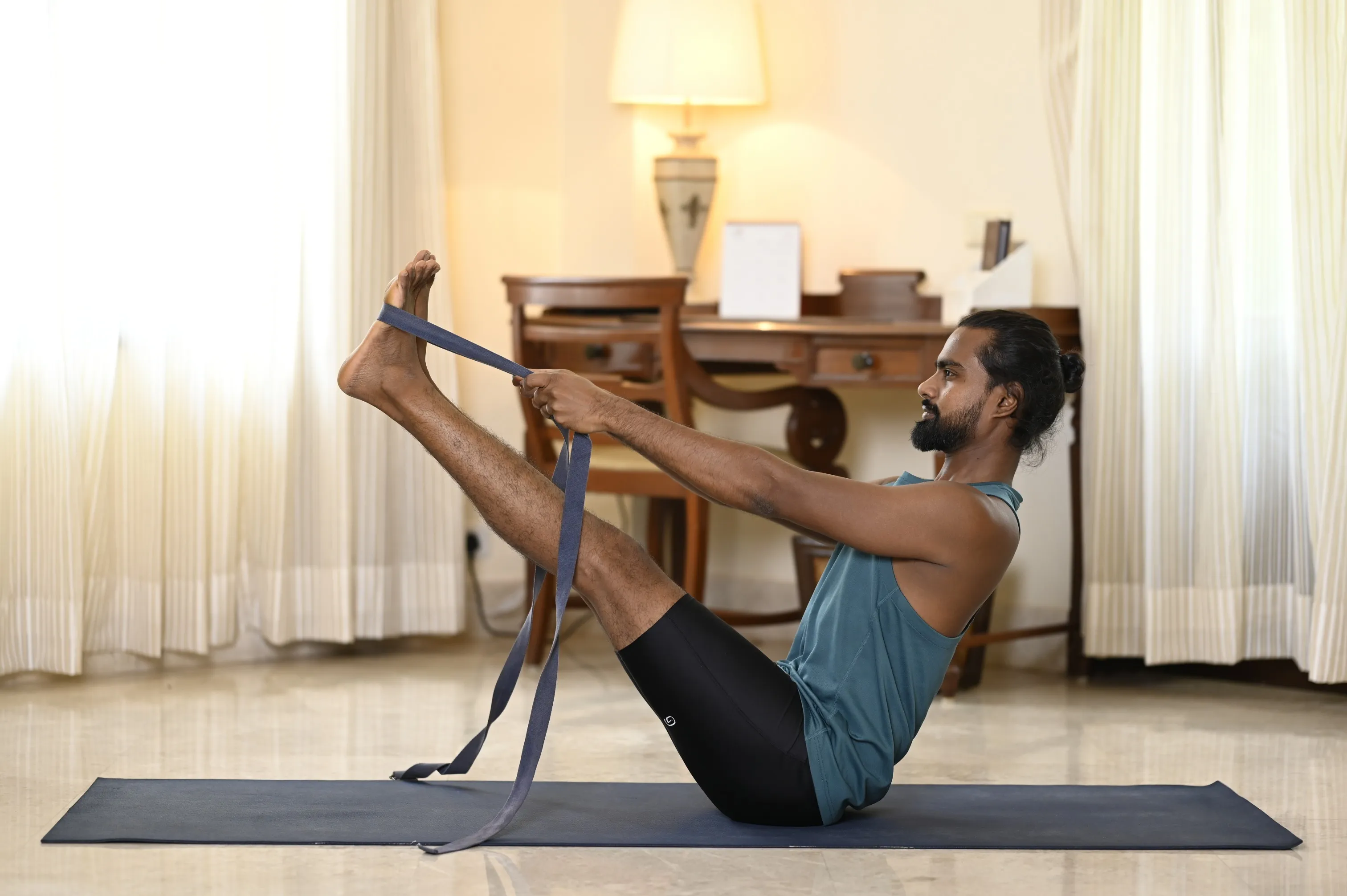What is Yoganidrasana (Yogic Sleep Pose)?
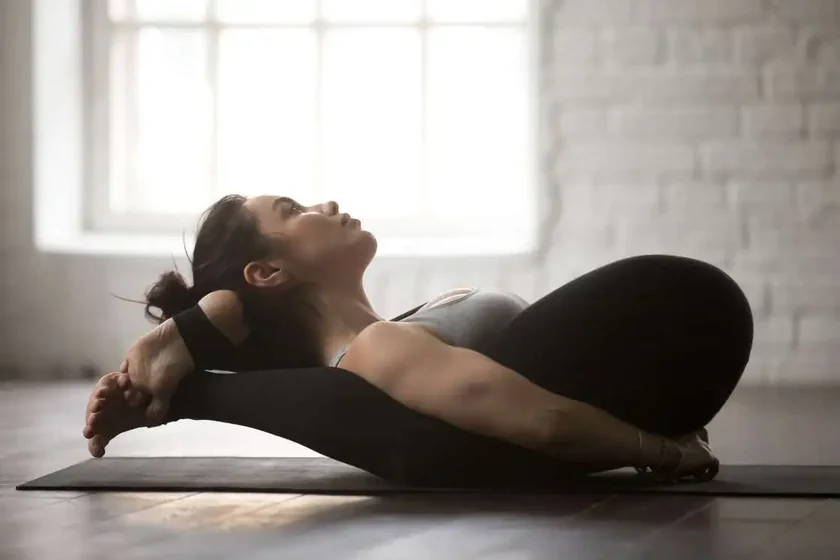
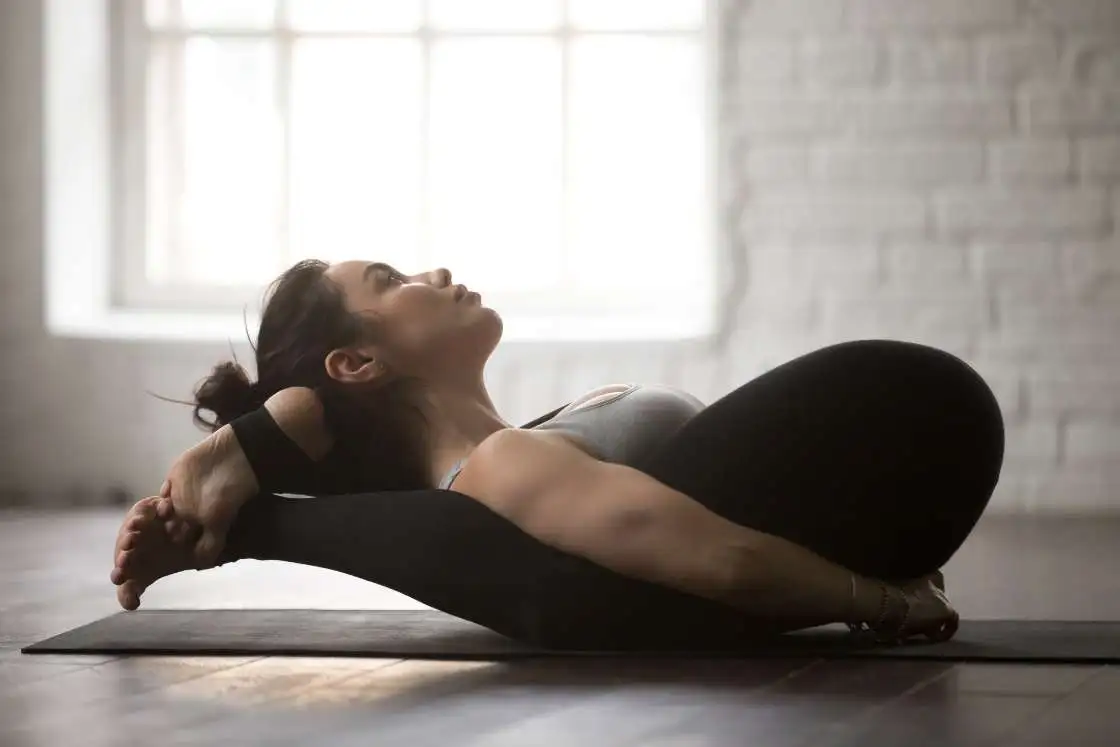
Yoganidrasana, or the Yogic Sleep Pose, is an advanced-level supine flexion for your glutes, legs, and pelvis.
Practitioners start this practice from a corpse position, place their feet behind the neck, and close their eyes to focus on their breath for a deep sleep-like experience.
The longer one can hold, the more this vital reclining stretch will aid in strengthening different body parts, like—the spine, tailbone, shoulders, chest, core, and hip flexors, making one's overall physic more robust, flexible, and lengthened.
If you are a beginner to Yoganidrasana, dive deep straight, and let's help you become familiar with its form.
Overview & Etymology
Sanskrit translation of Yoganidrasana is Yogic Sleep Pose. In the assortment of Sankrit words, 'Yoga' means 'to unite,' 'Nidra' means 'sleep,' and 'Asana' means 'posture' or 'seat.'
Yoga Nidra is more like a psychic sleep or supine meditation position, and it's referenced in Hindu and Buddhist cultures as a deep self-awareness practice.
According to the epic - Mahabharata, Lord Vishnu's Yoganidra position or sleeping cycle is equivalent to the cycle of one Yuga (existence of our material universe).
Also, Shaiva and Buddhist tantras connect Yoga Nidra to meditation.
As described in ancient Shaiva texts, Yoga Nidra offers "peace beyond words," while the Maha Maya Tantra talks about Yog Nidra as a state of perfect Buddhas who can access secret knowledge in Buddhism.
Yoga Nidra was first used as a synonym for Samadhi in the 11th and 12th centuries in Hatha and Raja yoga texts.
In the 14th century, the Yogatarvali described Yoga Nidra as removing "all thoughts of multiplicity" from the mind.
Next, it was described in the 17th Hatha yoga text—Haṭha Ratnavali, as a posture and in the 18th century as a painting of Eight Chakra.
According to Gheranda Samhita Yoga Nidra pose is not an asana but a Mudra (formation) to awaken the Kundalini Shakti (a form of divine energy within the human body).
Finally, it was presented in B.K.S Iyengar's 20th-century book—Light on Yoga, and from there, it started gaining popularity as a yoga pose.
Sanskrit Name: योगनिद्रासन Pronunciation: yoog-nee-drah-ahs-uh-nuh
Pose Type: Reclining Stretch Also known as: Yogic Sleep Pose
Strengthens: Neck, Back, Inner Thigs, Hip-Flexors, Glutes, Groin, and Knees
Stretches: Inner Thigs, Calfs, Hip-Flexors, Glutes, Groin, and Hamstrings
Health Benefits of Yoganidrasana
Soothes the brain.
Improves digestion.
Strengthens the neck.
Enhances overall flexibility.
Reduces stress and anxiety.
Stimulates the adrenal glands.
Strengthen and lengthen the legs.
Activates the Root and Sacral Chakra.
Increases blood flow in the whole body.
When to Avoid Performing Yoganidrasana
Avoid post-injury of surgery.
Avoid post-cesarian delivery.
Avoid if you have severe back pain.
Avoid if suffering from lumbar disc herniation.
How to do Yoganidrasana (Yogic Sleep Pose)
This detailed guide to Yoganidrasana has been divided into four easy-to-follow parts so that you can follow along while making quick progress.
Part 1 - Preparatory Poses for Yoganidrasana
To prepare your body for the yoga sleep pose, you should start with the following warm-up poses:
1. Surya Namaskar (Sun Salutations) - Stand in the mountain pose, and breathe in and out as your arms go overhead. Exhale, fold forward, inhale and half-lift your torso by keeping the palms on the ground.
Next, get into a plank position, exhale as you transition into the eight-angle pose, and slide the torso forward into the cobra pose with a deep breath.
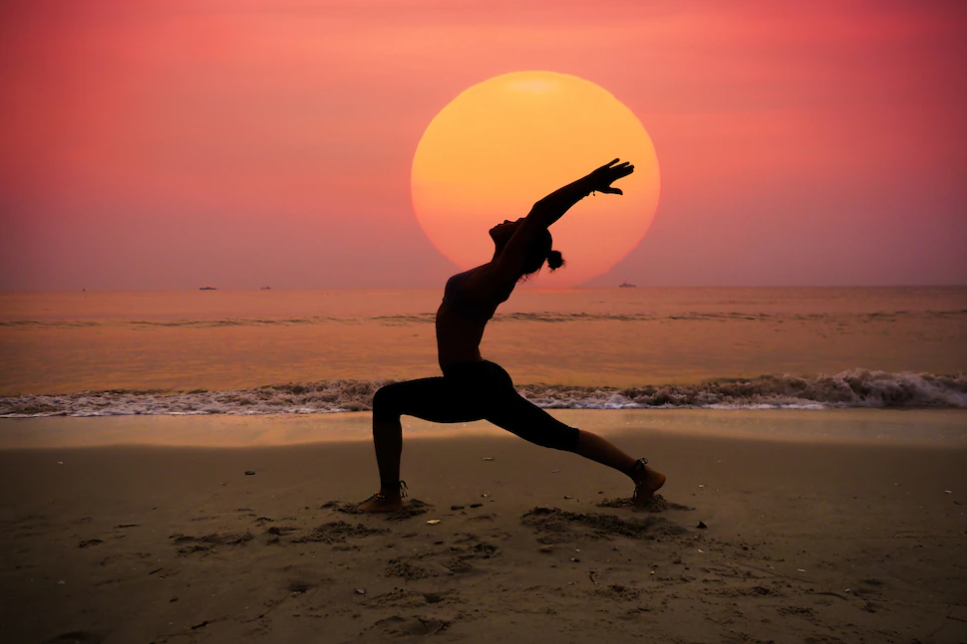
Exhale, press into your palms, and lift into the downward-facing dog. Bend your knees and walk towards your palms. Inhale and exhale, relax the spine in a forward fold, and finally stand back up to the mountain pose.
Perform these for 10 to 15 minutes and feel the whole body acquiring energy for the main pose.
2. Malasana (Garland Pose) - Get into a low squat position to activate your glutes, inner thighs, ankles, and spine. Open the legs wide, keep the glutes inline with your ankles, and the knees pointing on the side.
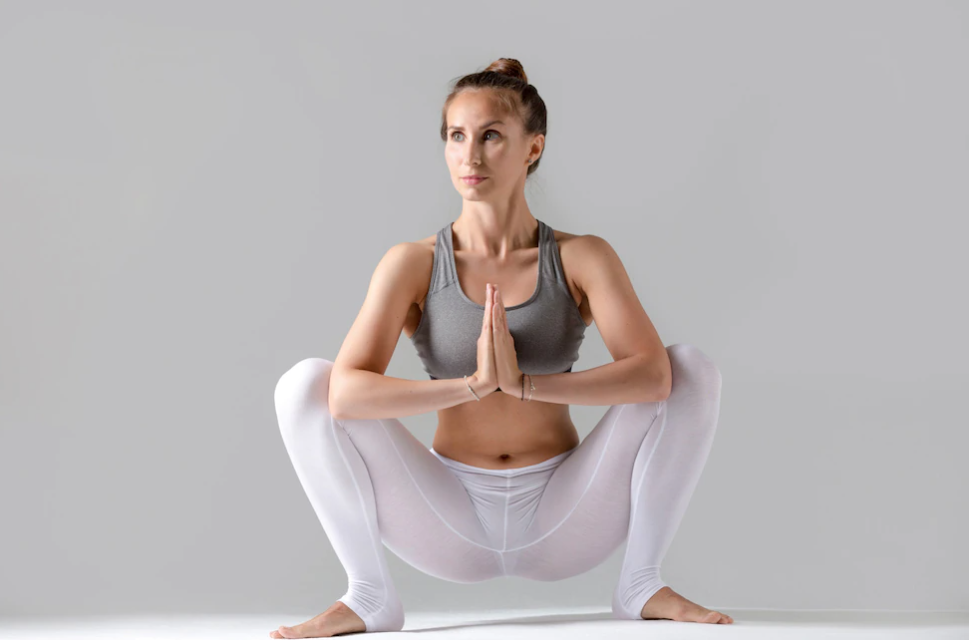
Add your arms close to the chest in Anjali Mudra and press your elbows on the sides of your legs, allowing them to open up more deeply. Hold this pose for 3 to 5 minutes.
Part 2: Step-by-Step Instructions to Perform Yoganidrasana
The following are steps to practice the yogic sleep pose:
Step 1- Start by lying on your back and bending both knees towards your chest. Breathe in and out here for a few seconds to channelize all your energy into your lower body.
Step 2- Next, take hold of your ankles or heels with your palms and draw your knees down towards the floor, below your armpits.
Step 3- Inhale, engage the core muscles, and raise the head above the floor.
Step 4- Rock forward and backward to ease into the yogic sleep position, and take each of your feet one by one behind the neck.
Step 5- Ensure the ankles are crossed behind the neck and the shoulder blades rest nicely over the cushion created by your calf muscles.
Step 6- As you feel your pelvis, inner thighs, and core muscles extending deeply, exhale and close your eyes.
Step 7- Once you find your sweet spot, gently align your hands by gripping the glutes.
Step 8- Focus on your breath and hold this pose for as long as you feel comfortable, and finally, exit gently by unwinding your crossed legs one by one.
Breath Awareness:
- Inhale - While engaging the core, raising the head and crossing the legs behind the neck.
- Exhale - While getting into the yogic sleep mode and right before releasing the pose.
- Inhale & Exhale - Before starting the pose and while holding the pose for a longer duration.
Performance Duration for Beginners: Hold the yogic sleep pose for 15 to 30 seconds.
Performance Duration for Advanced: Hold the yogic sleep pose for 60 to 90 seconds.
Part 3: Things to Keep in Mind
Forcing yourself for perfection without realizing your mistakes is not a wise choice, especially not while performing yoga asanas.
Thus, here are some posture cues to keep in mind before getting started with your practice:
Always warm up your body - In Yoganidrasana, the body requires a great deal of flexibility, so a lack of preparation can have some severe consequences.
Therefore, ensure your overall body is thoroughly active, loose, and open to get into the primary pose before getting started.
Focus on your breath - Holding the Yoganidrasana can be really intense, especially for beginners. Thus, be mindful, take control over your breath, and do not try to strain your muscles unnecessarily by holding the pose for too long if it feels painful.
Part 4: Relaxing Poses After Yoganidrasana
You will feel loads of physical stress in your glutes, neck, shoulders, spine, and pelvis after practicing Yoganidrasana. Therefore, try the following relax yoga poses to calm your nerves:
1. Halasana (Easy Plow Pose): Get into the downward-facing dog pose and place a pillow between your palms when your body is still warmed up.
Bring the top of your head closer to the floor, and roll over your spine between the arms such that the shoulders and upper back muscles are resting on the pillow.
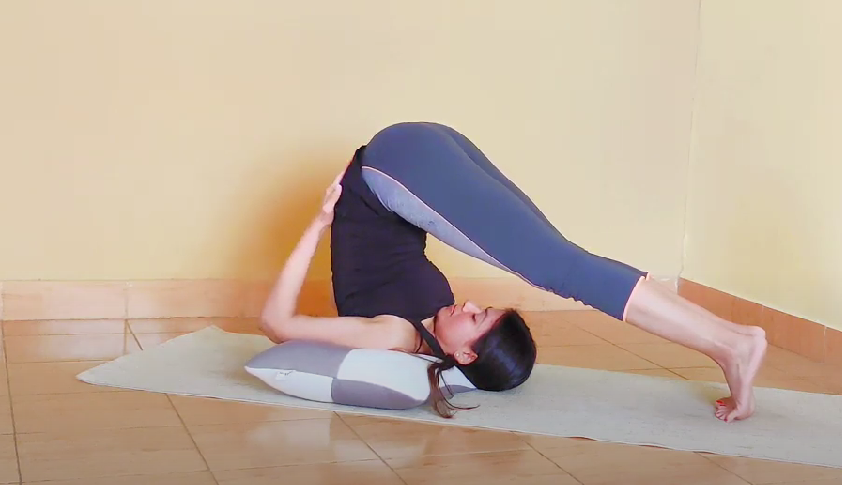
Adjust the neck, tighten the core, and keep the legs straight with the toes pointing. Lastly, bring your palms behind the lower back for more stability in the hold.
Hold your spine, neck, and shoulders in this counter stretch and bring all the tensed muscles back to their natural shape.
2. Baddha Konasana (Bound Angle Pose): This pose is excellent for calming your lower body and pelvic floor muscles. Start by sitting in Sukhaasana, inhale, and bring the soles of your feet together.
Adjust to bring your heels as close to your pelvis as comfortably as possible.
Hold your feet with your hands. Drop the knees wide on the sides and keep them close to the ground.
Exhale, fold forward, touch your forehead onto the floor, and breathe. Hold this pose until all the tension is released from the inner thighs, glutes, hamstrings, spine, and tailbone.
Yoganidrasana Variations to Consider
Once you feel strong enough in Yoganidrasana, try these variations to challenge your flexibility to the next level:
1. Yoganidrasana with Hands in Anjali Mudra - From the main Yogic Sleep Pose, bring your palms together and touch them together to create Anjali Mudra or Namaste formation.

This variation will challenge you to stabilize the glutes and lower back without any assistance.
2. Padma Yoganidrasana with Hands at Back - This one is only for advanced-level practitioners who feel an immense amount of flexibility in their spine and pelvis.

Get into the knees-to-chest pose, lift the head off the mat, and cross the legs in Padmasana to keep your shins close to the chest. Ensure to grip the back of your glutes with your palms so that the posture is firm and stable throughout the hold.

Enjoy a Free 1-on-1 Session with a Coach!
Receive personalized guidance tailored to your unique fitness goals, live with a dedicated coach—no credit card required.
Frequently Asked Questions about Yoganidrasana
Poses as Yoganidrasana aids in increasing the strength of deep pelvis muscles, hamstrings, calves, and glutes. This pose is perfect advance level asana for improving flexibility in the overall body.
Yoganidrasana is not suitable for beginners since it requires high flexibility and mindful breathing skills. Thus, in order to perform the yogic sleep pose with ease, you must first work on your physical strength, flexibility, and concentration.
Practice sun salutations for 10 to 15 minutes to activate blood circulation throughout the body.
Afterward, practice deep hip-openers like Baby Cradle Pose, Garland Pose, Compass Pose, Half Monkey Pose, etc., in order to prepare the lower-body muscles for your Yoganidrasana practice.
Stretches the glutes and inner thighs, activates the abdominal muscles, stimulates the adrenal glands, improves over all flexibility, builds strength in the lower body, and expands your heart—these are some popularly known health benefits of Yoganidrasana.
Beginners can hold the Yoganidrasana for 15 to 30 seconds. Whereas, advanced-level practitioners can take it as far as 90 seconds or even beyond, only if they feel comfortable.
Avoid Yoganidrasana if you are suffering from lumbar disc herniation or have been experiencing chronic back pain or any neck discomfort.
Also, avoid this practice temporarily if you’ve undergone any surgery, faced an injury, or feeling down due to your menstrual cycle.



%20(7).jpg)

